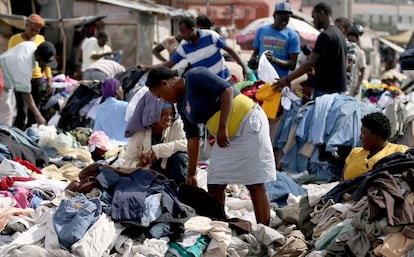Haitians still struggling to survive five years after earthquake
Initial plans to rebuild homes were too ambitious, say international aid groups

Five years after it was hit by a massive earthquake that measured 7.0 on the Richter scale and left around 300,000 people dead and 1.5 million homeless, debris no longer blocks the streets of the Haitian capital of Port-au-Prince.
But despite the $13.34 billion pledged by the international community for relief and recovery efforts and to help Haitian institutions get back on their feet, little has been done to build new housing or even repair existing structures devastated by the January 12, 2010 quake.
Haiti, the poorest country in the Western Hemisphere, and its fragile democracy are struggling just to survive.
Of the around 1,500 makeshift camps set up in 2010 to temporarily shelter displaced families, 123 remain. More than 85,000 people still live in them in poor sanitary conditions and without running water or electricity. They stand at risk of becoming the victims of whatever natural disaster might strike next.
Over a half of those living in the camps have no access to a latrine or if they do, have to share it with about 80 other people.
Amnesty International warns reduced funding threatens essential services at the existing camps
“Living conditions in camps today remain extremely precarious,” warns Amnesty International in a report released earlier this month that condemns how victims are being denied access to adequate housing. “The provision of essential services has been progressively declining over the years owing to reduced funding and the greater priority given to closing the camps.”
The majority of those who have left the camps have returned to where they once lived before the earthquake or been evicted by force. A third of those who left have received subsidies from public and private institutions to help them pay for rent.
But there has never been enough housing for everyone in Haiti, even before the tragedy. The same year the quake struck, there was a 500,000-housing-unit shortage in Port-au-Prince alone. And in the five years that have followed, international aid agencies have only been able to build about 9,000 homes.
The United States planned on constructing 15,000 homes but has only built 2,600 since the quake struck
Countries and organizations involved in rebuilding Haiti have reached the conclusion that their initial plans were too ambitious. “We had expected many more donors to come forward to partner with us to build new homes, new settlements, and those funds did not materialize,” said Elizabeth Hogan, acting assistant administrator for the Latin America and Caribbean bureau at the US Agency for International Development (USAID), during a teleconference on January 8.
The United States, one of the countries that has contributed most money, planned on constructing 15,000 homes but has only built 2,600 in the past five years. Among the reasons are the high costs involved, which turned out to be three times more than US officials originally projected.
But as the camps continue to close, Port-au-Prince is gradually growing in the north. More than 200,000 Haitians have begun to build homes and create makeshift neighborhoods in open spaces in the Canaan, Jerusalem and Onaville sectors.
In rough numbers, Haitians today are less poor than they were a decade ago. According to a World Bank report released in December, extreme poverty has been reduced to 23.8 percent in 2012 from 31 percent in 2000. But 70 percent of the population is still considered poor or stands to be reduced to poverty if another natural disaster or disease epidemic strikes the country.
Tu suscripción se está usando en otro dispositivo
¿Quieres añadir otro usuario a tu suscripción?
Si continúas leyendo en este dispositivo, no se podrá leer en el otro.
FlechaTu suscripción se está usando en otro dispositivo y solo puedes acceder a EL PAÍS desde un dispositivo a la vez.
Si quieres compartir tu cuenta, cambia tu suscripción a la modalidad Premium, así podrás añadir otro usuario. Cada uno accederá con su propia cuenta de email, lo que os permitirá personalizar vuestra experiencia en EL PAÍS.
¿Tienes una suscripción de empresa? Accede aquí para contratar más cuentas.
En el caso de no saber quién está usando tu cuenta, te recomendamos cambiar tu contraseña aquí.
Si decides continuar compartiendo tu cuenta, este mensaje se mostrará en tu dispositivo y en el de la otra persona que está usando tu cuenta de forma indefinida, afectando a tu experiencia de lectura. Puedes consultar aquí los términos y condiciones de la suscripción digital.
Últimas noticias
The complicated life of Francesca Albanese: A rising figure in Italy but barred from every bank by Trump’s sanctions
Half of Scotland is in the hands of 420 property owners
Pinochet’s victims grapple with José Antonio Kast’s rise in Chile
Reinhard Genzel, Nobel laureate in physics: ‘One-minute videos will never give you the truth’
Most viewed
- Pablo Escobar’s hippos: A serious environmental problem, 40 years on
- Why we lost the habit of sleeping in two segments and how that changed our sense of time
- Charles Dubouloz, mountaineering star, retires at 36 with a farewell tour inspired by Walter Bonatti
- Trump’s obsession with putting his name on everything is unprecedented in the United States
- The Florida Keys tourist paradise is besieged by immigration agents: ‘We’ve never seen anything like this’









































